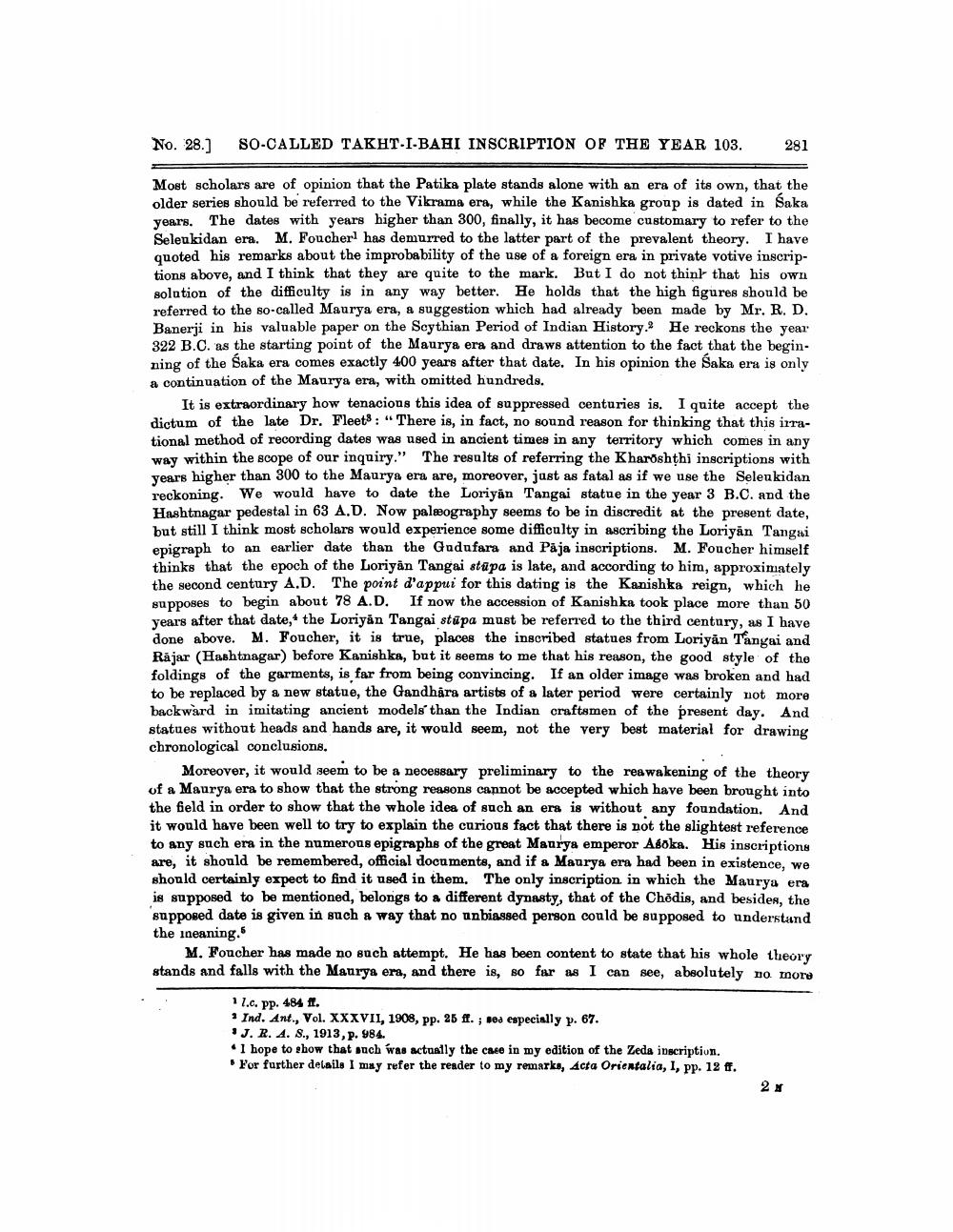________________
No. 28.)
SO-CALLED TAKHT-I-BAHI INSCRIPTION OF THE YEAR 103.
281
Most scholars are of opinion that the Patika plate stands alone with an era of its own, that the older series should be referred to the Vikrama era, while the Kanishka group is dated in Saka years. The dates with years higher than 300, finally, it has become customary to refer to the Seleukidan era. M. Foucher has demurred to the latter part of the prevalent theory. I have quoted his remarks about the improbability of the use of a foreign era in private votive inscriptions above, and I think that they are quite to the mark. But I do not think that his own solution of the difficulty is in any way better. He holds that the high figures should be referred to the so-called Maurya era, a suggestion which had already been made by Mr. R. D. Banerji in his valuable paper on the Scythian Period of Indian History. He reckons the year 322 B.C. as the starting point of the Maurya era and draws attention to the fact that the beginning of the Saka era comes exactly 400 years after that date. In his opinion the Saka era is only a continuation of the Maurya era, with omitted hundreds.
It is extraordinary how tenacions this idea of suppressed centuries is. I quite accept the dictum of the late Dr. Fleet : " There is, in fact, no sound reason for thinking that this irrational method of recording dates was used in ancient times in any territory which comes in any way within the scope of our inquiry." The results of referring the Kharðshthi inscriptions with years higher than 300 to the Maurya era are, moreover, just as fatal as if we use the Seleukidan reckoning. We would have to date the Loriyan Tangai statue in the year 3 B.C. and the Hashtnagar pedestal in 63 A.D. Now paleography seems to be in discredit at the present date, but still I think most scholars would experience some difficulty in ascribing the Loriyan Tangai epigraph to an earlier date than the Gudufara and Påja inscriptions. M. Foucher himself thinks that the epoch of the Loriyan Tangai stūpa is late, and according to him, approximately the second century A.D. The point d'appui for this dating is the Kanishka reign, which he supposes to begin about 78 A.D. If now the accession of Kanishka took place more than 50 years after that date," the Loriyan Tangai stūpa must be referred to the third century, as I have done above. M. Foucher, it is true, places the inscribed statues from Loriyan Tangai and Rājar (Hashtnagar) before Kanishka, but it seems to me that his reason, the good style of the foldings of the garments, is far from being convincing. If an older image was broken and had to be replaced by a new statue, the Gandhara artists of a later period were certainly not more backward in imitating ancient models than the Indian craftsmen of the present day. And statues without heads and hands are, it would seem, not the very best material for drawing chronological conclusions.
Moreover, it would seem to be a necessary preliminary to the reawakening of the theory of a Maurya era to show that the strong reasons cannot be accepted which have been brought into the field in order to show that the whole idea of such an era is without any foundation. And it would have been well to try to explain the curious fact that there is not the slightest reference to any such era in the numerous epigraphs of the great Maurya emperor Asoka. His inscriptions are, it should be remembered, official documents, and if a Maurya era had been in existence, we shonld certainly expect to find it used in them. The only inscription in which the Maurya era is supposed to be mentioned, belongs to a different dynasty, that of the Chodis, and besides, the supposed date is given in such a way that no unbiassed person could be supposed to understand the ineanings
M. Foncher has made no such attempt. He has been content to state that his whole theory stands and falls with the Maurya era, and there is, so far as I can see, absolutely no more
11.c. Pp. 484 ft. 1 Ind. Ant., Vol. XXXVII, 1908, pp. 25 ff. ; sos especially p. 67. 'J. R. A. 8., 1913, p. 984. . I hope to show that such was actually the case in my edition of the Zeda inscription. For further details I may refer the reader to my remarks, Acta Orientalia, 1, pp. 12 ff.




